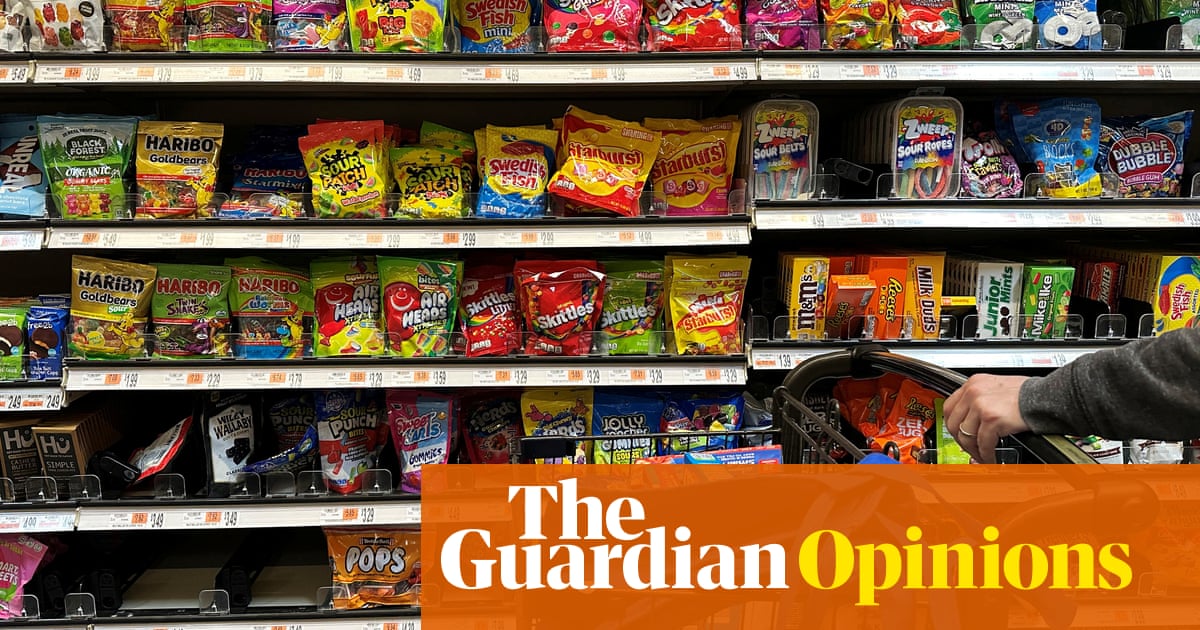One of my favourite memories as a child growing up in Miami was going to the local fair and having bright-blue cotton candy – candy floss, as you’d call it in Britain. My siblings and I would stick out our tongues to compare how blue they were. Sometimes as blue as the milk in our Lucky Charms cereal bowls, where the marshmallows shaped like blue moons, horseshoes and rainbows coloured anything that got in contact with them. Candy corn was a staple on Halloween, and corn syrup jugs were ubiquitous at Thanksgiving to bake pumpkin and pecan pies. These were rare treats – we were an immigrant family who largely ate traditional Indian food – and for that caution, I’m grateful.
We now know how artificial food colourings affect the cognitive, behavioural, metabolic and nutritional development of children, and how they are linked to attention deficit hyperactivity disorder (ADHD). This includes my favourite brilliant blue dye. A 2024 scientific review of theevidencetitled Synthetic Colors in Food: A Warning for Children’s Health refers to the possible toxicity levels of these additives, and suggests substituting dyes from completely natural sources instead.
Finding any of those dyes in Britain and the EU is pretty difficult, and they’re covered with warnings when you do. In 1995, the UK government passedlegislation(the colours in food regulations) that banned certain colours in food production and required labelling (either by name or by something called an E number) if any of a certain list of chemical food colours were used in manufacturing. Going further, in 2008,the Food Standards Agencysuggested that UK manufacturers should remove artificial food colours, given emerging evidence linking these chemicals to ADHD in children.
The UK did not go as far as a complete ban on these colourings, like most EU countries did, but since 2010, food and drink containing certain artificial colourings must carry a warning on the packaging: “may have an adverse effect on activity and attention in children”. Rather than carry this warning, most food manufacturers have switched to natural sources of food colouring such as beetroot, turmeric, matcha and spirulina.
EU governments and the UK government had to step in with this legislation because just leaving it to the food industry wasn’t enough. Unfettered capitalism is dangerous, with the motivations being sales and producing products in the cheapest way possible, even if they have probable negative health impacts. How is a busy parent supposed to know which cereal is full of E colours that could adversely affect the development of their child, and which cereal is using natural colours? Labelling is a large step forward, as well as warnings. Even better would be to make sure what’s on the shelves isn’t going to make you or your loved ones sick or impaired.
I was recently back in the US, and those artificial dyes are still being sold in the same products from my childhood 30 years ago. In one of his last acts in office this January, former president Joe Bidenbanned the dyered 3 in food manufacturing after studies linked the chemical to cancer in male rats. However, food manufacturers have until 2027 to phase the colouring out, meaning foods with this dye such as cakes, candies and cookies are still being sold without any warning on the label.
While in EU countries and Britain food safety guidance has evolved with the evidence and to protect consumer safety, US supermarkets and shops are full of products being marketed and sold to children with multiple Es in them, and additives and colourings that are banned or being phased out in other countries.The larger portion sizes and ubiquitous fast food might be most visible when comparing the US to Europe, but the hidden, more insidious difference is what chemicals are regulated and allowed in the food supply.
With a potential UK-US trade deal including food, the difference in standards presents challenges, and potential slippage into a lower safety bar. We’ve heard of concerns about antibiotics in US meat, and chlorinated chicken, but not about the import of products from the US that don’t meet UK safety standards. We actually have more in common with Europe in terms of food safety, and a trade deal with the EU would improve our food safety baseline.
Things are slowly changing in the US, from a surprising source. Robert F Kennedy Jr, the health and human services secretary, has a range ofbizarre and dangerous views, buthe’s speakingabout regulating these additives and food colourings under the Maha – or “make America healthy again” – slogan. Maha supporters like to proclaim that this is pioneering. It’s not. Americans love to think we’re world-leading. Sometimes, we’re just behind the curve. In this case, very far behind Europe, and more than a decade behind Britain.
While back in the US, I caught up with a friend from England who now lives in Miami. I told her that I had gone into multiple supermarkets looking for ultraprocessed products that didn’t contain something banned or regulated in Europe. Ingredient lists were full of possibly toxic chemicals, yet being sold with no warning or flagging to consumers of what they were buying. She laughed and said, “You’re looking in the wrong section. Go to the British section of the supermarket and you’ll find safer food there.” Who would have thought that the British options would be the healthier options?
Prof Devi Sridhar is chair of global public health at the University of Edinburgh
